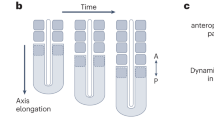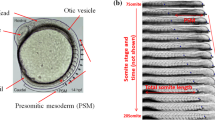Abstract
Somites are condensations of mesodermal cells that form along the two sides of the neural tube during early vertebrate development. They are one of the first instances of a periodic pattern, and give rise to repeated structures such as the vertebrae. A number of theories for the mechanisms underpinning somite formation have been proposed. For example, in the “clock and wavefront” model (Cooke and Zeeman in J. Theor. Biol. 58:455–476, 1976), a cellular oscillator coupled to a determination wave progressing along the anterior-posterior axis serves to group cells into a presumptive somite. More recently, a chemical signaling model has been developed and analyzed by Maini and coworkers (Collier et al. in J. Theor. Biol. 207:305–316, 2000; Schnell et al. in C. R. Biol. 325:179–189, 2002; McInerney et al. in Math. Med. Biol. 21:85–113, 2004), with equations for two chemical regulators with entrained dynamics. One of the chemicals is identified as a somitic factor, which is assumed to translate into a pattern of cellular aggregations via its effect on cell–cell adhesion. Here, the authors propose an extension to this model that includes an explicit equation for an adhesive cell population. They represent cell adhesion via an integral over the sensing region of the cell, based on a model developed previously for adhesion driven cell sorting (Armstrong et al. in J. Theor. Biol. 243:98–113, 2006). The expanded model is able to reproduce the observed pattern of cellular aggregates, but only under certain parameter restrictions. This provides a fuller understanding of the conditions required for the chemical model to be applicable. Moreover, a further extension of the model to include separate subpopulations of cells is able to reproduce the observed differentiation of the somite into separate anterior and posterior halves.
Similar content being viewed by others
References
Armstrong, N.J., Painter, K.J., Sherratt, J.A., 2006. A continuum approach to modelling cell–cell adhesion. J. Theor. Biol. 243, 98–113.
Bagnall, K.M., Higgins, S.J., Sanders, E.J., 1989. The contribution made by cells from a single somite to tissues within a body segment and assessment of their integration with similar cells from adjacent segments. Development 107, 931–943.
Baker, R.E., Schnell, S., Maini, P.K., 2006a. A clock and wavefront mechanism for somite formation. Dev. Biol. 293, 116–126.
Baker, R.E., Schnell, S., Maini, P.K., 2006b. A mathematical investigation of a clock and wavefront model for somitogenesis. J. Math. Biol. 52, 458–482.
Baker, R.E., Schnell, S., Maini, P.K., 2008. Mathematical models for somite formation. Curr. Top. Dev. Biol. 81, 183–203.
Bothe, I., Ahmed, M.U., Winterbottom, F.L., von Scheven, G., Dietrich, S., 2007. Extrinsic versus intrinsic cues in avian paraxial mesoderm patterning and differentiation. Dev. Dyn. 236, 2397–2409.
Cheney, C.M., Lash, J.W., 1984. An increase in cell–cell adhesion in the chick segmental plate results in a meristic pattern. J. Embryol. Exp. Morphol. 79, 1–10.
Collier, J.R., McInerney, D., Schnell, S., Maini, P.K., Gavaghan, D.J., Houston, P., Stern, C.D., 2000. A cell cycle model for somitogenesis: Mathematical formulation and numerical simulation. J. Theor. Biol. 207, 305–316.
Cooke, J.R., Zeeman, E.C., 1976. A clock and wavefront model for control of the number of repeated structures during animal morphogenesis. J. Theor. Biol. 58, 455–476.
Dale, K.J., Pourquié, O., 2000. A clock-work somite. Bioessays 22, 72–83.
Duband, J.L., Dufour, S., Hatta, K., Takeichi, M., Edelman, G.M., Thiery, J.P., 1987. Adhesion molecules during somitogenesis in the avian embryo. J. Cell. Biol. 104, 1361–1374.
Dubrulle, J., McGrew, M.J., Pourquié, O., 2001. FGF signaling controls somite boundary position and regulates segmentation clock control of spatiotemporal Hox gene activation. Cell 106, 219–232.
Dubrulle, J., Pourquié, O., 2004a. Coupling segmentation to axis formation. Development 131, 5783–5793.
Dubrulle, J., Pourquié, O., 2004b. fgf8 mRNA decay establishes a gradient that couples axial elongation to patterning in the vertebrate embryo. Nature 427(6973), 419–422.
Foty, R.A., Steinberg, M.S., 2004. Cadherin-mediated cell–cell adhesion and tissue segregation in relation to malignancy. Int. J. Dev. Biol. 48, 397–409.
Foty, R.A., Steinberg, M.S., 2005. The differential adhesion hypothesis: A direct evaluation. Dev. Biol. 278, 255–263.
Gerisch, A., 2008. On the approximation and efficient evaluation of integral terms in PDE models of cell adhesion. Submitted.
Gerisch, A., Chaplain, M., 2008. Mathematical modelling of cancer cell invasion of tissue: local and nonlocal models and the effect of adhesion. J. Theor. Biol. 250, 684–704.
Glazier, J.A., Zhang, Y., Swat, M., Zaitlen, B., Schnell, S., 2008. Coordinated action of N-CAM, N-cadherin, EphA4, and ephrinB2 translates genetic prepatterns into structure during somitogenesis in chick. Curr. Top. Dev. Biol. 81, 205–247.
Grima, R., Schnell, S., 2007. Can tissue surface tension drive somite formation? Dev. Biol. 307, 248–257.
Hatta, K., Takagi, S., Fujisawa, H., Takeichi, M., 1987. Spatial and temporal expression pattern of N-cadherin cell adhesion molecules correlated with morphogenetic processes of chicken embryos. Dev. Biol. 120, 215–227.
Hillen, T., Painter, K.J., 2001. A parabolic model with bounded chemotaxis—prevention of overcrowding. Adv. Appl. Math. 26, 280–301.
Horikawa, K., Radice, G., Takeichi, M., Chisaka, O., 1999. Adhesive subdivisions intrinsic to the epithelial somites. Dev. Biol. 215, 182–189.
Kimura, Y., Matsunami, H., Inoue, T., Shimamura, K., Uchida, N., Ueno, T., Miyazaki, T., Takeichi, M., 1995. Cadherin-11 expressed in association with mesenchymal morphogenesis in the head, somite, and limb bud of early mouse embryos. Dev. Biol. 169, 347–358.
Kulesa, P.M., Schnell, S., Rudloff, S., Baker, R.E., Maini, P.K., 2007. From segment to somite: segmentation to epithelialization analyzed within quantitative frameworks. Dev. Dyn. 236, 1392–1402.
Lash, J.W., Linask, K.K., Yamada, K.M., 1987. Synthetic peptides that mimic the adhesive recognition signal of fibronectin: differential effects on cell–cell and cell-substratum adhesion in embryonic chick cells. Dev. Biol. 123, 411–420.
Lewis, J., Ozbudak, E.M., 2007. Deciphering the somite segmentation clock: beyond mutants and morphants. Dev. Dyn. 236, 1410–1415.
Linask, K.K., Ludwig, C., Han, M.D., Liu, X., Radice, G.L., Knudsen, K.A., 1998. N-cadherin/catenin-mediated morphoregulation of somite formation. Dev. Biol. 202, 85–102.
McGrew, M.J., Dale, K., Fraboulet, S., Pourquié, O., 1998. The lunatic Fringe gene is a target of the molecular clock linked to somite segmentation in avian embryos. Curr. Biol. 8, 979–982.
McInerney, D., Schnell, S., Baker, R.E., Maini, P.K., 2004. A mathematical formulation for the cell-cycle model in somitogenesis: Analysis, parameter constraints and numerical solutions. Math. Med. Biol. 21, 85–113.
Meinhardt, H., 1986. Models of segmentation. In: Somites in Developing Embryos, pp. 179–189. Plenum, New York.
Ostrovsky, D., Cheney, C.M., Seitz, A.W., Lash, J.W., 1983. Fibronectin distribution during somitogenesis in the chick embryo. Cell. Differ. 13, 217–223.
Palmeirim, I., Henrique, D., Ish-Horowicz, D., Pourquié, O., 1997. Avian hairy gene expression identifies a molecular clock linked to vertebrate segmentation and somitogenesis. Cell 91, 639–648.
Pourquié, O., 2001. Vertebrate somitogenesis. Ann. Rev. Cell. Dev. Biol. 17, 311–350.
Primmett, D., Norris, W., Carlson, G., Keynes, R., Stern, C., 1989. Periodic segmental anomalies induced by heat shock in the chick embryo are associated with the cell cycle. Development 105, 119–130.
Primmett, D.R., Stern, C.D., Keynes, R.J., 1988. Heat shock causes repeated segmental anomalies in the chick embryo. Development 104, 331–339.
Saga, Y., Takeda, H., 2001. The making of the somite: molecular events in vertebrate segmentation. Nat. Rev. Genet. 2, 835–845.
Schnell, S., Maini, P.K., McInerney, D., Gavaghan, D.J., Houston, P., 2002. Models for pattern formation in somitogenesis: A marriage of cellular and molecular biology. C. R. Biol. 325, 179–189.
Steinberg, M.S., 1962. On the mechanism of tissue reconstruction by dissociated cells, III. Free energy relations and the reorganization of fused, heteronomic tissue fragments. PNAS 48, 1769–1776.
Stern, C.D., Keynes, R.J., 1987. Interactions between somite cells: the formation and maintenance of segment boundaries in the chick embryo. Development 99, 261–272.
Stern, C.D., Fraser, S.E., Keynes, R.J., Primmett, D.R.N., 1988. A cell lineage analysis of segmentation in the chick embryo. Development 104S, 231–244.
Takeichi, M., 1988. The cadherins: cell–cell adhesion molecules controlling animal morphogenesis. Development 102, 639–655.
Weiner, R., Schmitt, B., Podhaisky, H., 1997. Rowmap—a row-code with Krylov techniques for large stiff odes. Appl. Num. Math. 25, 303–319.
Author information
Authors and Affiliations
Corresponding author
Additional information
N.J. Armstrong was supported by a Doctoral Training Account Studentship from EPSRC. K.J. Painter and J.A. Sherratt were supported in part by Integrative Cancer Biology Program Grant CA113004 from the US National Institute of Health and in part by BBSRC grant BB/D019621/1 for the Centre for Systems Biology at Edinburgh.
Rights and permissions
About this article
Cite this article
Armstrong, N.J., Painter, K.J. & Sherratt, J.A. Adding Adhesion to a Chemical Signaling Model for Somite Formation. Bull. Math. Biol. 71, 1–24 (2009). https://doi.org/10.1007/s11538-008-9350-1
Received:
Accepted:
Published:
Issue Date:
DOI: https://doi.org/10.1007/s11538-008-9350-1




